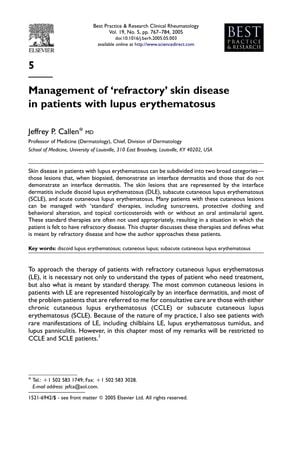Management of Refractory Skin Disease in Patients with Lupus Erythematosus
September 2005
in “
Best Practice & Research Clinical Rheumatology
”
corticosteroids retinoids antimalarials sulfasalazine auranofin thalidomide phenytoin azathioprine methotrexate mycophenolate mofetil biologic agents cytokine therapy sunscreens protective clothing topical corticosteroids intralesional corticosteroids steroids biologics topical steroids intralesional steroids

TLDR The document concludes that treating tough skin disease in lupus involves sun protection, steroids, antimalarials, and various other therapies chosen based on individual risks and benefits.
The 2005 document reviews the management of refractory skin disease in lupus erythematosus patients, particularly chronic and subacute forms. It emphasizes the importance of sun protection due to high photosensitivity in these patients and outlines various treatments, including topical therapies like corticosteroids and retinoids, and systemic therapies such as antimalarials, which are less effective in smokers. Sulfasalazine was successful in 8 out of 11 patients, auranofin showed complete remission in 15% of patients, and thalidomide was highly effective but had serious side effects. Phenytoin was excellent in 90% of 93 patients, and immunosuppressives like azathioprine, methotrexate, and mycophenolate mofetil were beneficial for severe cases. Biologic agents and cytokine therapy showed promise but lacked long-term safety data. The document concludes that standard therapy includes sunscreens, protective clothing, topical and intralesional corticosteroids, and oral antimalarials, with alternative therapies being a personal choice after risk-benefit discussions. Specific study participant numbers for each treatment are not provided.


